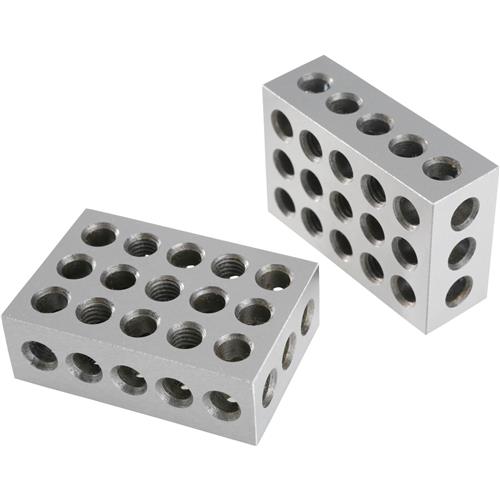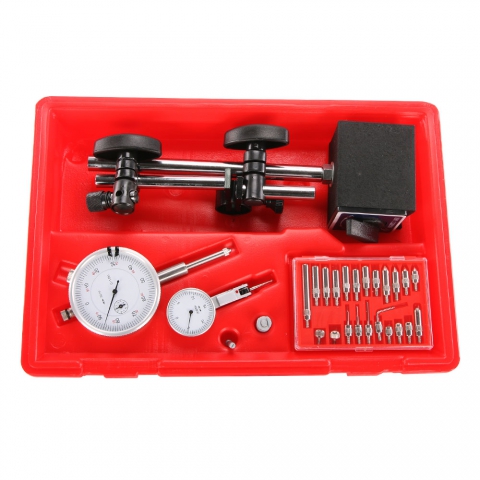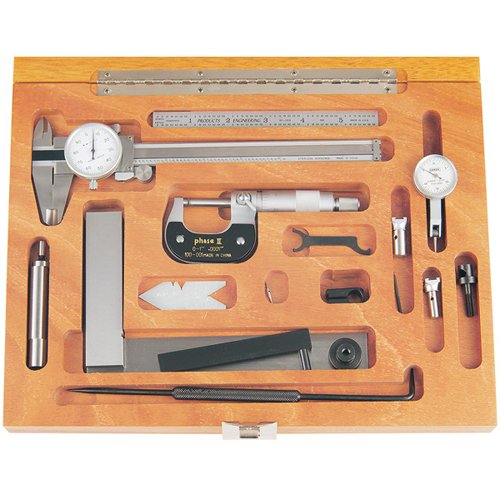i will put a +1 for a good file. i like single cut files because they work great for getting the bur off after milling or turning. get a good quality file and you can create smoother surface than milling! im pretty sure the files i have are second cut. if you keep them clean they will cut like crazy. you really only need one or two nice ones.
You are using an out of date browser. It may not display this or other websites correctly.
You should upgrade or use an alternative browser.
You should upgrade or use an alternative browser.
The beginners tool box
- Thread starter Tin Falcon
- Start date

Help Support Home Model Engine Machinist Forum:
This site may earn a commission from merchant affiliate
links, including eBay, Amazon, and others.
Tin Falcon
Well-Known Member
- Joined
- Jul 9, 2007
- Messages
- 7,207
- Reaction score
- 787
Transfer punches are a tool not yet mentioned. Like drill bits they come in many sizes 115 different sizes for imperial and then of course a metric set.

the idea is you have a part that needs to mate to another part you . The first part has holes in it the second part needs holes that align with the first part . you clamp the two together then use these punches to "transfer"hole locations.
these are available from many vendors and the presentaion may vary from tool roll to plastic or metal stand.
Tin

the idea is you have a part that needs to mate to another part you . The first part has holes in it the second part needs holes that align with the first part . you clamp the two together then use these punches to "transfer"hole locations.
these are available from many vendors and the presentaion may vary from tool roll to plastic or metal stand.
Tin
- Joined
- May 27, 2010
- Messages
- 2,999
- Reaction score
- 1,171
Transfer Punches.
Long time ago,thought these were essential items. Drilling matching holes to accept flanges was a hit & miss and pain in the side.
After buying one set from UK vendor and all my mismatching woes are over.
Gus now looking for other essential tools not discovered.
Oh Yeah!!! Corner radius mills.
Looking for brand new old fashion H.T. Ignition Coil for Webbie equally tough.
Long time ago,thought these were essential items. Drilling matching holes to accept flanges was a hit & miss and pain in the side.
After buying one set from UK vendor and all my mismatching woes are over.
Gus now looking for other essential tools not discovered.
Oh Yeah!!! Corner radius mills.
Looking for brand new old fashion H.T. Ignition Coil for Webbie equally tough.
A good old-fashioned hacksaw was one of the items in my first year apprentice toolbox.
Indispensable for cutting stock to rough size, seized bolts, slotting, parting (ok ok sit down in the back row) and with a 10" bastard file and 10" millsaw file can substitute for a milling machine in many instances.
Always slacken off the wing nut after use so the blade is not under tension during storage. This stops the frame from bending and getting slack over the years. My apprentice hacksaw is still in use in my home workshop 40 years later. I still find its use much more "therapeutic" than a noisy angle grinder that throws sparks and grit all over the shop.
Indispensable for cutting stock to rough size, seized bolts, slotting, parting (ok ok sit down in the back row) and with a 10" bastard file and 10" millsaw file can substitute for a milling machine in many instances.
Always slacken off the wing nut after use so the blade is not under tension during storage. This stops the frame from bending and getting slack over the years. My apprentice hacksaw is still in use in my home workshop 40 years later. I still find its use much more "therapeutic" than a noisy angle grinder that throws sparks and grit all over the shop.
Tin Falcon
Well-Known Member
- Joined
- Jul 9, 2007
- Messages
- 7,207
- Reaction score
- 787
How about 1-2-3 blocks.

many used for setup and layout.
Tin

many used for setup and layout.
Tin
How can or could anyone argue with Terry's points? The thread title was "Beginners tool box" Ok fine, a DI and DTI really aren't optional, and..........will never be optional in my simple and humble opinion. However I can't say the same for a lot of the other optional tools others have listed here.How about a dial indicator, magnetic base, and dial test indicator set?? This one is from littlemachineshop.com

I could I guess mention a decent range of educational books. Anyone remember books? I don't know about anyone else, but learning and understanding how to think about all this is just as important as the latest damn tool you can buy.
Learning and understanding that concept takes a hell of a long time. At least it did for me.
Pete
Tin Falcon
Well-Known Member
- Joined
- Jul 9, 2007
- Messages
- 7,207
- Reaction score
- 787
So Pete show us your list of beginners essentials.
and what do think is missing from our list?
Tin
and what do think is missing from our list?
Tin
- Joined
- May 27, 2010
- Messages
- 2,999
- Reaction score
- 1,171
May I suggest feeler gages to set ignition contact points?
Alchymist
Well-Known Member
- Joined
- Dec 21, 2010
- Messages
- 66
- Reaction score
- 19
May I suggest feeler gages to set ignition contact points?
I have 4 or 5 sets of feeler gauges here and there among the tool boxes. Most haven't been used much. Not a lot of points ignition systems anymore, even on small gas engines. Not that they aren't handy for some other things.....
Tin Falcon
Well-Known Member
- Joined
- Jul 9, 2007
- Messages
- 7,207
- Reaction score
- 787
Here is an import kit from Travers tools

$ 154 so likely import but nice small box to keep the tools in and sows the basics.
Tin

$ 154 so likely import but nice small box to keep the tools in and sows the basics.
Tin
So Pete show us your list of beginners essentials.
and what do think is missing from our list?
Tin
I just read through this list for a second time, and I'm thing we need to start a document for beginners even intermediate level machinists. After awhile it ought to distill into something that is very useful for a beginner. Being new here I'm not sure where such a document should be stored.
I like this thread as it should be helpful to many. I have a few things to add to the list.
1.
Tweezers, in this case fine point for removing the nasties that get stuck in out hands.
2.
4-1/2" right angle grinder. Now I know many a machinist will cringe at the thought of such a device in a shop but I see it as a very good cost effective investment for a beginner. It can be used to cut up stock, grind and fit stock for everything from a work bench to a casting for what ever you are building. It is a cheap solution that is good enough until you acquire better equipment. Further if you need to fabricate anything for your shop it might be seen as required.
3.
A one inch belt sander.
4.
A chisel and punch set.
5.
Magnifiers.
1.
Tweezers, in this case fine point for removing the nasties that get stuck in out hands.
2.
4-1/2" right angle grinder. Now I know many a machinist will cringe at the thought of such a device in a shop but I see it as a very good cost effective investment for a beginner. It can be used to cut up stock, grind and fit stock for everything from a work bench to a casting for what ever you are building. It is a cheap solution that is good enough until you acquire better equipment. Further if you need to fabricate anything for your shop it might be seen as required.
3.
A one inch belt sander.
4.
A chisel and punch set.
5.
Magnifiers.
Tin Falcon
Well-Known Member
- Joined
- Jul 9, 2007
- Messages
- 7,207
- Reaction score
- 787
A chisel and punch set.
Magnifiers.
YES pin punches can be very handy. prick punch center punch and chisels.
magnifiers handy for the over 40 crows which I guess is a majority here.
tin
YES pin punches can be very handy. prick punch center punch and chisels.
magnifiers handy for the over 40 crows which I guess is a majority here.
tin
Yes moving past 50 does change what is mandatory in ones toolbox. It is one of the reasons I prefer digital devices such as calipers and iMacs these days.
- Joined
- May 27, 2010
- Messages
- 2,999
- Reaction score
- 1,171
I have 4 or 5 sets of feeler gauges here and there among the tool boxes. Most haven't been used much. Not a lot of points ignition systems anymore, even on small gas engines. Not that they aren't handy for some other things.....
You are right. Honda/Robin Petrol Engines went CDI in the 1990s(maybe earlier).Prior to that Petrol Engine drive compressor packages comes back for contact point replacement during the warranty period.Left it to my repairmen to take care.Sad. Never had time to familiarise with CDI in the assembly plant.
CDI with Johnson Outboard Engines were burning off like firecrackers in the 80s.Somehow they always break down after warranty period and expensive to replace.
Old fashion contact point can be hard to tune for advance and retard.My service supervisor does a great job get the timing perfect.Watched him do it by watching the radiator water in rush every time he vrooms engine.Gus never mastered it.
Now comtemplating to switch over to CDI for Webbie to improve the engine firing during idling. How sad .Contact points and feeler gages now belong to Jurassic Period.
- Joined
- May 27, 2010
- Messages
- 2,999
- Reaction score
- 1,171
YES pin punches can be very handy. prick punch center punch and chisels.
magnifiers handy for the over 40 crows which I guess is a majority here.
tin
Gus is somehow lucky.At 70 he can still read conventional mikes n vernier calipers with one slightly cataractic right eye.
But I am still struggling with pin punching on the cross hair.:wall::hDe:
Removing splinters is a problem but I bought a tweezer with magnifying glass from TokyuHands.
Digital mikes sure help.
Hopefully.I have ten more years of good eyesight and health to build engines.
Surface gauges, in conjunction with a flat surface(surface plate, drill press table) and your combination square, are another means of laying out holes on a work piece. Starrett makes them in several sizes.
http://content.yudu.com/A290vg/Star...?referrerUrl=http://www.starrett.com/catalogs
Tom
p.s. This link gets you to the catalogue. Then click on "precision shop tools", then go to page 321. I Have a no. 57 and a no. 56. The smaller one is handier for model work.
http://content.yudu.com/A290vg/Star...?referrerUrl=http://www.starrett.com/catalogs
Tom
p.s. This link gets you to the catalogue. Then click on "precision shop tools", then go to page 321. I Have a no. 57 and a no. 56. The smaller one is handier for model work.
Last edited:
Screw machine drills are shorter than jobber drills, and are very handy when your lathe doesn't have much distance between centers.
Tom
This is a good point short drills solve space issues not just in a lathe but also milling machines and drill presses.
Now some may resist the temptation to buy yet another set of drill bits but there is a way to end up with a set without actually buying a set. This involves a Drill Doctor or other sharpening method for the drill bits in question. The trick here is to never throw out perfectly good drill bits but to resharpen as needed. Normal sharpening would eventually get you there.
However if the drill bit is worn in the margin it may still be savable. Instead of throwing it away use a cutoff wheel to clip the drill bit past the worn margin and then use the Drill Doctor to re establish the pint shape. Usually you can end up with a usable drill with two or three re settings of the bit in the Drill Doctor. This may sound like more work for the Drill Doctor than it is designed for but is seems to hold up fine for limited use. Of course this works with any drill grinding system that can re establish a drills point. I just mention the Drill Doctor because it is the approach I've used recently and it is pretty trouble free. Atleast in the context of medium sized drill bits.
The point here is that you need to sharpen drill bits anyways. Combine that with the fact that some operations will wear the Margin more than others resulting in the need at times to clip the drill bit. Eventually you will have a set of short drills without buying them. In fact drill bits are good tool steel, one should keep then around as long as possible.
Similar threads
- Replies
- 0
- Views
- 527
- Replies
- 0
- Views
- 298



